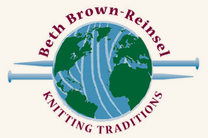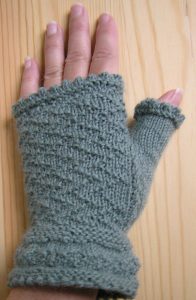Aran
Aran knitting brings to mind the lovely heavily textured and cabled sweaters from the Aran Islands of Ireland. Created in the early 1900s for the tourist trade, Aran sweaters have become some of the most popular types of garments to knit and wear. Traditionally made of undyed, woolen-spun three-ply wool yarn, the typical gauge today is 4 to 5 stitches per inch.
Continental
This is a style of knitting in which the working yarn is held in the left hand and “picked”. It is also known as German style. See Tutorial.
Corrugated Ribbing
Seen often in Fair Isle and Scandinavian garments, this ribbing is made of as few as two two colors (one color for the knit ribs, one color for the purl ribs) or as many colors as one likes!
English
This is a style of knitting in which the working yarn is held in the right hand and “thrown”. See Tutorial
Fair Isle
Fair Isle knitting is so named for Fair Isle, one of the Shetland Islands of Scotland. It refers specifically to the color use and layout of garments made there, though some use the term erroneously to mean all types of stranded knitting. While gloves and hats were made in the late 1800s, vests and sweaters were developed in this style in the early 1900s. As the background colors transition from dark to light to dark, the pattern colors transition from light to dark to light.
Felting/ Fulling
Fulling is the process of felting fabric that has been made by knitting weaving, crochet, or nålbinding. (Felting refers to this process as applied to unspun fibers.) Wool fibers are comprised of overlapping scales which enmesh with each other when subjected to agitation. It cannot be undone, as many of us know who unwittingly threw that new cashmere sweater in the washer and it came out sized for our three year old. Fulled garments will wear longer, and they won’t unravel if a hole develops. They are very warm, as there are no gaps for the wind and cold to penetrate. It’s amazing that when one WANTS to full something, it takes a bit of work and time. But it’s not hard and really is fun! Certain aboriginal felters rarely use much water in this process, relying more on agitation (stomping on the fibers). Other felters use lots of water. along with their agitation.
Intarsia
The technique of knitting designs using only one yarn at any given time, although many yarns may be used within a row. Bobbins may be used to hold the different yarns as the knitting progresses. Although this method is generally worked on flat knitting, there are instances of it being adapted for circular knitting (also known as modified intarsia). When changing from one color yarn to another, a twist must be made to avoid holes in the fabric.
Gansey, Guernsey
The true fisherman sweater which was popular in the 1800s and early 1900s in England and Scotland. similar designs even showed up in The Netherlands. These circularly knitted garments were hard wearing and made of knit/purl combinations and sometimes simple cables in a worsted-spun five-ply yarn at seven stitches per inch or more. Special gussets under the arms and on the shoulders or neck add to the fit and give knitters an enjoyable challenge.
Gusset
A triangular or diamond shaped piece, found in the underarms, shoulder area, and necks of the British Gansey (and garments of other traditions), and in socks and mittens that helps contour the knitting through the use of increases and/or decreases to create a better fit.
Kitchener Stitch
This method of joining is for two pieces of knitting that have not been bound off. With the stitches still on the needles, the yarn is threaded onto a tapestry needle and the yarn is “woven” through the stitches in the pathway of a regular knit row, yielding an invisible join. This method is not usually strong enough for shoulder seams but is commonly used for sock toes.
Latvian Knitting
The beautifully intricate, gusset less mittens of Latvia are often given as gifts. They are characterized by a pointed tip and lots of colors and different patterns. Sometimes, the cuffs are scalloped or fringed.
Norwegian Purl
This is a Continental style purl stitch that is made with the yarn always held in the back of the work. Because of the improved angle of the yarn, the stitch is easier to complete. It also makes two color purling on the wrong side of the work a breeze! This method is practiced in many of the Scandinavian countries.
Provisional Cast-Ons
Some cast-ons create the foundation edge from which to knit, while at the same time, give the opportunity to pick up stitches from the other end to knit in the opposite direction. These are known as provisional cast-ons. You can see a video of the Invisible Provisional Cast-on on this website, but there are many others. A new Provisional Cast-on has been developed by Ann Turley Dreith, that has the advantage over the Invisible Cast-on in that the stitches aren’t twisted in the end. She very generously has allowed me to share her PDF of the technique here.
S and Z yarns
All yarns are either spun in an S direction or a Z direction. The two possibilities of twist direction are named for the center section of the two letters S and Z which characterize the angle of those twists.
Scandinavian Knitting
Any knitting that originates from Sweden, Norway, or Denmark, usually characterized by stranded color work. Because Scandinavia had a strong weaving tradition before knitting was introduced, some garments, though not all, are created as a tube and then cut and sewn like fabric.
Steek
“Steek” is a Scottish term for extra stitches added to a knitted garment which will eventually be cut to form an opening, such as an armhole or cardigan front. Steeks are used in Fair Isle garments as well as some Scandinavian garments. Some are 10 sts wide and rely on the quatlity of the wool to keep the cut stitches from raveling. Others are made of only a few stitches and must be stabilized by machine sewing or crochet.
Twined Knitting
Developed in the 1600s in Sweden, this method creates a strong, very warm knitted fabric. In Swedish the term is Tvåändsstickning, meaning two-end knitting, because both ends of a ball of yarn are used. Every other stitch is worked with one or the other yarn, and they twist (or twine) around each other. While one yarn creates the matrix of the fabric, the other yarn is free to float on the surface creating lovely motifs. Twined knitting can also be worked in multiple colors.
Stranded Knitting
Knitting comprised of two or more yarns worked within the same row or round to create color patterns. As one yarn is knitted, the other yarn waits its turn to be used, stranding along the back of the work.
Woolen yarn
This term refer to yarns made of wool that has been carded to align the fibers which are then spun at a perpendicular angle to the alignment. This results in a lofty, warm yarn owing to the air spaces created by the fiber preparation.
Worsted yarn
This term refers to yarns made of wool that has been combed to align the fibers ( a more refined process than carding) and remove the shorter fibers which would detract from the smoothness. This results in a dense, strong yarn that is resistant to abrasion.







